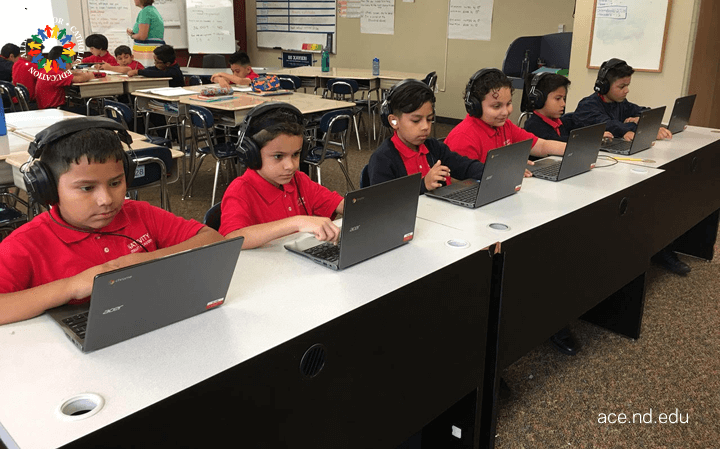Most of us have heard the tales about Catholic schools with low enrollment and poor academic performance that adopt blended learning as a final effort to remain open and offer a high-quality education to more students. But we don't often hear about schools that already have high-performing, full classrooms and challenge themselves to innovate. In fact, it is easy to understand why the leader of such a school might think, "If it ain't broke, don't fix it."
 But Melodie Wyttenbach thought differently. In 2013, Melodie was the president of Nativity Jesuit Academy, a thriving Jesuit middle school for young men. The school was doing well-so well, in fact, that it was beginning a process of expanding to become a PK-8, co-ed school. In the midst of that expansion, though, Melodie wanted to make another great change: to incorporate blended learning into the school's instructional model.
But Melodie Wyttenbach thought differently. In 2013, Melodie was the president of Nativity Jesuit Academy, a thriving Jesuit middle school for young men. The school was doing well-so well, in fact, that it was beginning a process of expanding to become a PK-8, co-ed school. In the midst of that expansion, though, Melodie wanted to make another great change: to incorporate blended learning into the school's instructional model.
"During graduate school, I had an amazing professor who kept talking about how technology would disrupt education and had the power to change and improve our traditional education system," Melodie told me. "I knew that he was right, but then I wanted to know who was using technology as a disrupter in Catholic schools." Melodie soon came across Seton Education Partners and applied to join their network of Catholic, blended-learning schools the following year.
"We already had a strong school culture and high levels of instruction," Melodie explained. "But what we needed was for teachers to have the tools to really differentiate and for students to play a bigger part in owning their learning." Because Nativity articulated these goals for blended learning nearly a year before the model launched in the school, Nativity used them to shape every piece of its model.
And because Melodie, her leadership team, and the rest of the faculty agreed on these goals for the program, it made it easy for them to provide a rationale for implementing blended learning to parents. "In conversing with parents, we shared the identified needs of our students and the innovative way to meet these needs, which was really powerful. Parents trusted that we were doing the best thing for their children."
Before the implementation, Melodie was also able to prepare her teachers for the changes to come. Throughout the 2013-14 school year, the Nativity teachers explored different programs, learned about various blended learning models, and visited a number of blended schools. "We spent that year planting the seed of what this change would mean for their instructional practice," Melodie explained. "By the time we officially partnered with Seton, the teachers generally knew what to expect and were on board to make the changes."
With that said, the school's partnership with Seton began pretty seamlessly in 2014 and Nativity began to see indicators of success almost instantly-namely, increased student motivation and confidence. "It was amazing to see how quickly the students began to own and articulate their own growth. Students would stop me in the hallways to tell me about a rise in their pass rate or their Lexile level. And they would also celebrate one another's successes, too. The students were all just genuinely excited about learning."

Melodie left Nativity shortly after it transitioned to the blended model to serve as the academic director of the Remick Leadership Program, but she did so knowing that her school was in great hands with the leadership team and support from Seton-and the school's continued success is certainly a testament to that. The school's enrollment has doubled in three years, and I regularly cite it as one of the single best examples of blended learning in Catholic schools (read about one of the outstanding teachers from Nativity here).
Given this impressive history, I asked Melodie to share some tips for leaders who are considering whether or not to "go blended," and she provided two outstanding nuggets of wisdom:
-
Clearly articulate your vision and rationale for going blended. It is critical that you have a clear rationale you can articulate to stakeholders. If this is not in place, you will undoubtedly encounter pushback from teachers, parents, students, or donors and not get the buy-in you need to effectively implement this model.
-
Know the capacity of your school. It is essential that leaders know their community and how the community members will respond to this change-especially teachers, who drive the implementation in the classrooms. School leaders have to know how to build capacity in and provide support to their teachers in order to make this major transition a success.
We are so grateful to Melodie for sharing her wisdom with our community and for supporting our blended learning initiatives here at ACE! And now we want to hear from you: what was your school's purpose for going blended?
 Alliance for Catholic Education
Alliance for Catholic Education
